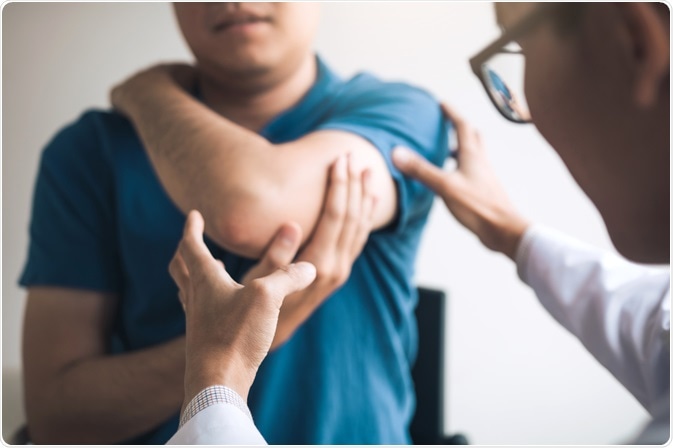Kinesiology, derived from the Greek word for movement, 'kinesis', is the study of the mechanics of bodily movements. This branch of study was started by Dr. George Goodheart, who was a chiropractor, but later absorbed the techniques of traditional Chinese medicine, including acupuncture, to set up a model of disease as a disturbance of energy flow in the body, rather than as a physical entity.
It evaluates health by exploring the biofeedback from muscles. A key principle of applied kinesiology includes identifying stress which strains the whole body and that may manifest objectively as a weakening of a single muscle.

Image Credit: wutzkohphoto / Shutterstock
Kinesiology visualizes muscles as linked to specific organs, and it uses manual muscle testing to evaluate the health of the patient. Whereas conventional medicine uses muscle testing as a means of assessing the structural and functional health of the neuromuscular unit, applied kinesiology makes use of this technique to understand organ-related, nutritional or emotional imbalances in the body.
This testing employs the strength or weakness of a muscle to get information about the organ that it is linked to, and the requirement of the body for a particular nutrient. The muscle testing employed is by holding the muscle in isometric contraction against resistance applied externally, rather than voluntary contraction against an immovable object. This is called Kendall’s technique. Provocative tests are used along with muscle testing.
This form of manual muscle testing thus identifies the problem, whether in the physical (in relation to the nervous, muscular or skeletal system), emotional or biochemical (metabolic) realm, as well as in the mental, non-organic sphere, with disease which is not arising or related to the symptomatic systems. Practitioners of applied kinesiology claim to promote physical, emotional, mental and spiritual health by identifying and treating these problems.
Kinesiologists try to work with and utilize the healing powers, or life forces, of the body itself. They draw support from Chinese acupuncture, as well as from chiropractics. It is also partly based upon applied kinesiology, which measures muscle strength. It is therefore not based upon the Western model of medicine, visualizing the body rather as an energy system.
Kinesiology treatment should be best done in conjunction with conventional medical treatment. Some of the techniques this profession employs include:
- Lymphatic massage
- Acupressure
- Hypertonic muscle release
- Treatment of attention, reflex and trigger points
- Nutritional advice
- Flower therapy
- Homeopathy
- Joint manipulations/mobilizations
- Myofascial releases
- Meridian therapy
- Acupuncture
- Counseling
- Environmental modification
Kinesiology thus uses conservative, non-invasive methods of treatment. The present state of literature on this subject does not, however, lend credibility to the claims of applied kinesiology that manual muscle testing can be used for diagnosis of disease, or preclinical, or subclinical, conditions.
Studies do not show any significant increase in muscle strength, which is to be expected from the theoretical framework of applied kinesiology. Moreover, studies of sufficient experimental quality to be cited in relation to the basic diagnostic claims of applied kinesiology either refute or do not support these claims, making it a valueless tool.
References
Further Reading